M&S Management Style: Analysis of CEO's Style, Change in Structure, Leadership Style, Motivation Strategies, Power and Conflict
VerifiedAdded on 2023/06/18
|13
|3817
|296
AI Summary
This article discusses the management style of the CEO of Marks & Spencer, including the use of the Management Grid Model, change in structure, leadership style, motivation strategies, and the effects of power and conflict in the company. The CEO, Stephen Joseph Rowe, uses a team management style and a transformational leadership style to enhance the effectiveness of the company. The company uses Maslow's theory as a motivation strategy and different forms of power, including legitimate, coercive, and expert power.
Contribute Materials
Your contribution can guide someone’s learning journey. Share your
documents today.
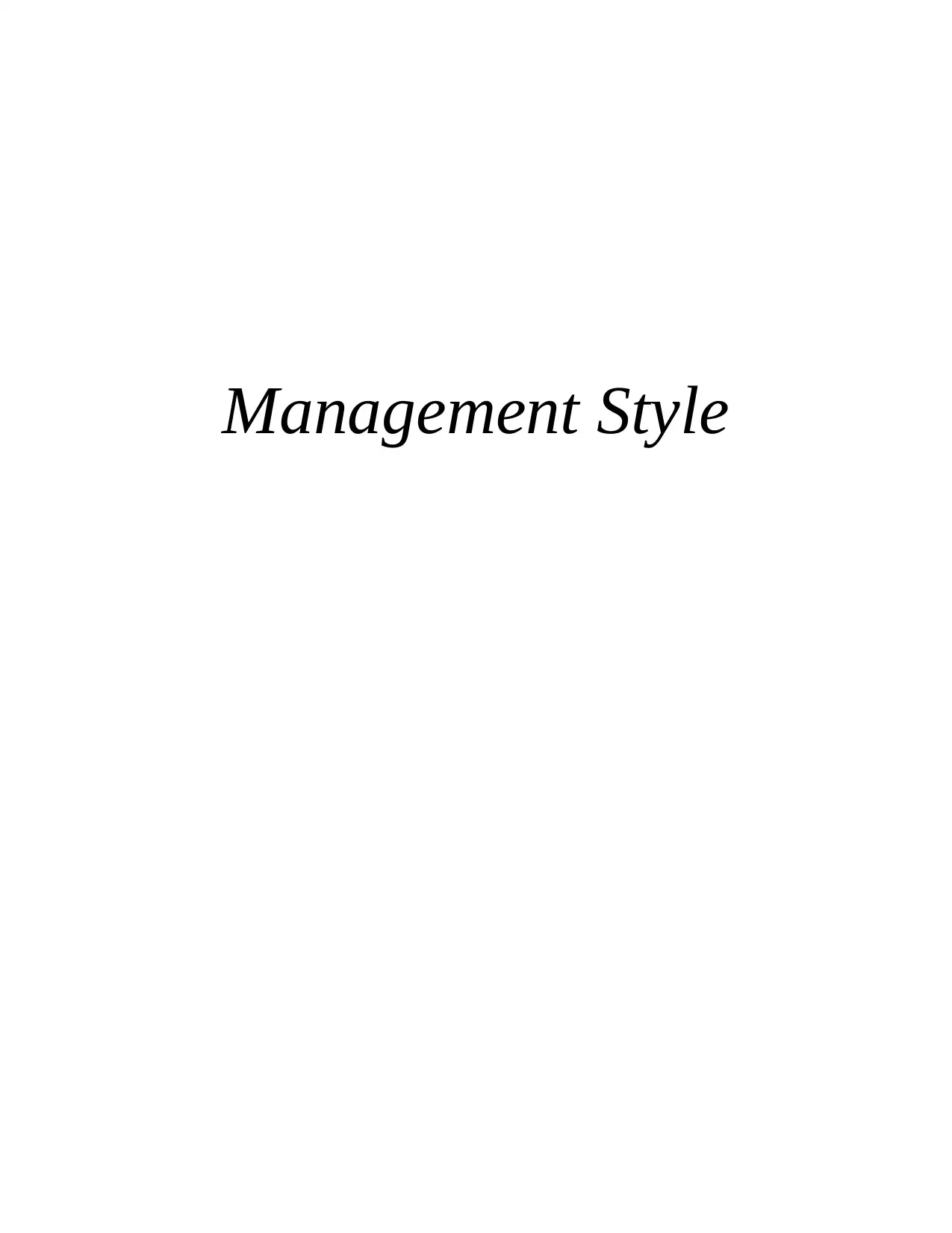
Management Style
Secure Best Marks with AI Grader
Need help grading? Try our AI Grader for instant feedback on your assignments.
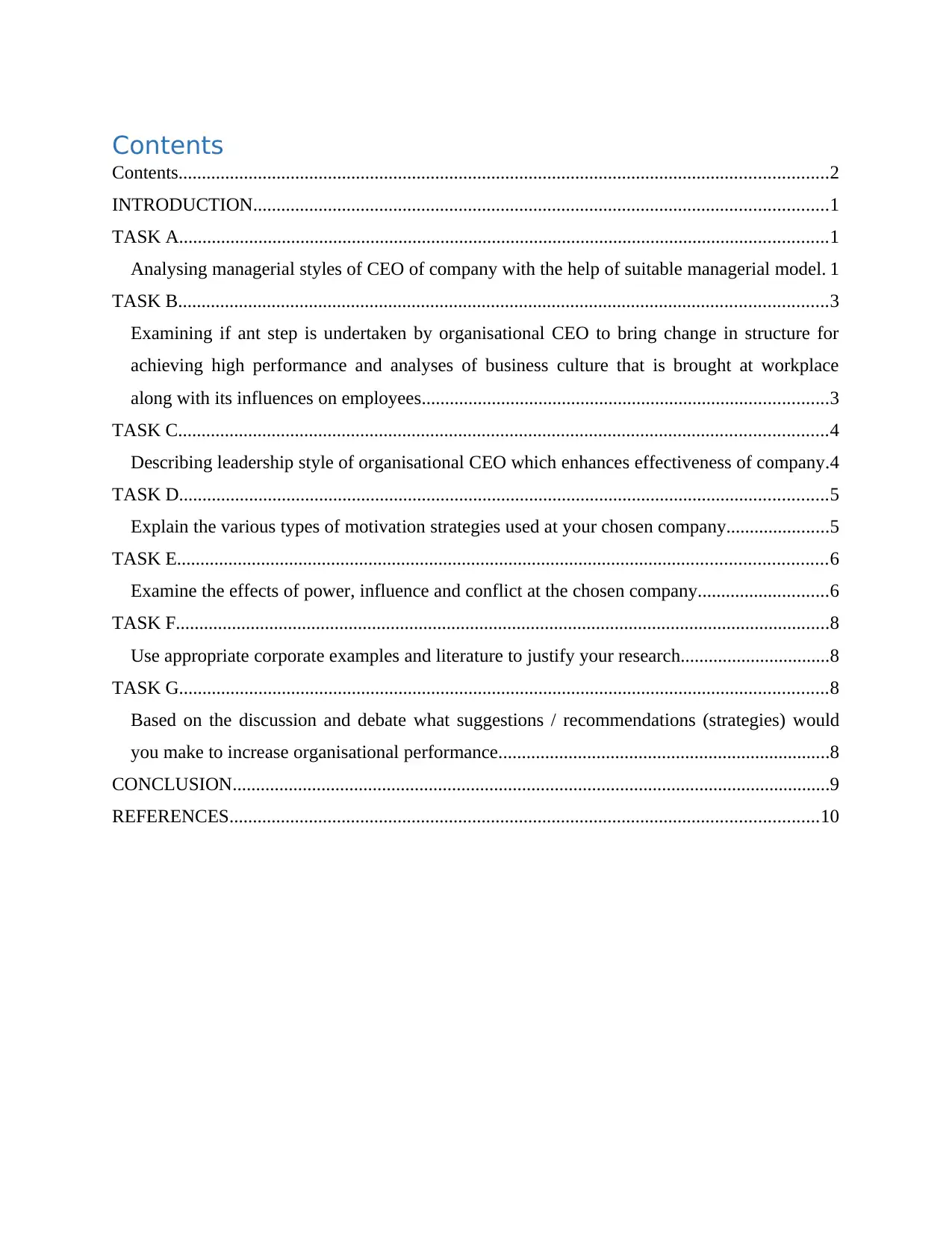
Contents
Contents...........................................................................................................................................2
INTRODUCTION...........................................................................................................................1
TASK A...........................................................................................................................................1
Analysing managerial styles of CEO of company with the help of suitable managerial model. 1
TASK B...........................................................................................................................................3
Examining if ant step is undertaken by organisational CEO to bring change in structure for
achieving high performance and analyses of business culture that is brought at workplace
along with its influences on employees.......................................................................................3
TASK C...........................................................................................................................................4
Describing leadership style of organisational CEO which enhances effectiveness of company.4
TASK D...........................................................................................................................................5
Explain the various types of motivation strategies used at your chosen company......................5
TASK E...........................................................................................................................................6
Examine the effects of power, influence and conflict at the chosen company............................6
TASK F............................................................................................................................................8
Use appropriate corporate examples and literature to justify your research................................8
TASK G...........................................................................................................................................8
Based on the discussion and debate what suggestions / recommendations (strategies) would
you make to increase organisational performance.......................................................................8
CONCLUSION................................................................................................................................9
REFERENCES..............................................................................................................................10
Contents...........................................................................................................................................2
INTRODUCTION...........................................................................................................................1
TASK A...........................................................................................................................................1
Analysing managerial styles of CEO of company with the help of suitable managerial model. 1
TASK B...........................................................................................................................................3
Examining if ant step is undertaken by organisational CEO to bring change in structure for
achieving high performance and analyses of business culture that is brought at workplace
along with its influences on employees.......................................................................................3
TASK C...........................................................................................................................................4
Describing leadership style of organisational CEO which enhances effectiveness of company.4
TASK D...........................................................................................................................................5
Explain the various types of motivation strategies used at your chosen company......................5
TASK E...........................................................................................................................................6
Examine the effects of power, influence and conflict at the chosen company............................6
TASK F............................................................................................................................................8
Use appropriate corporate examples and literature to justify your research................................8
TASK G...........................................................................................................................................8
Based on the discussion and debate what suggestions / recommendations (strategies) would
you make to increase organisational performance.......................................................................8
CONCLUSION................................................................................................................................9
REFERENCES..............................................................................................................................10

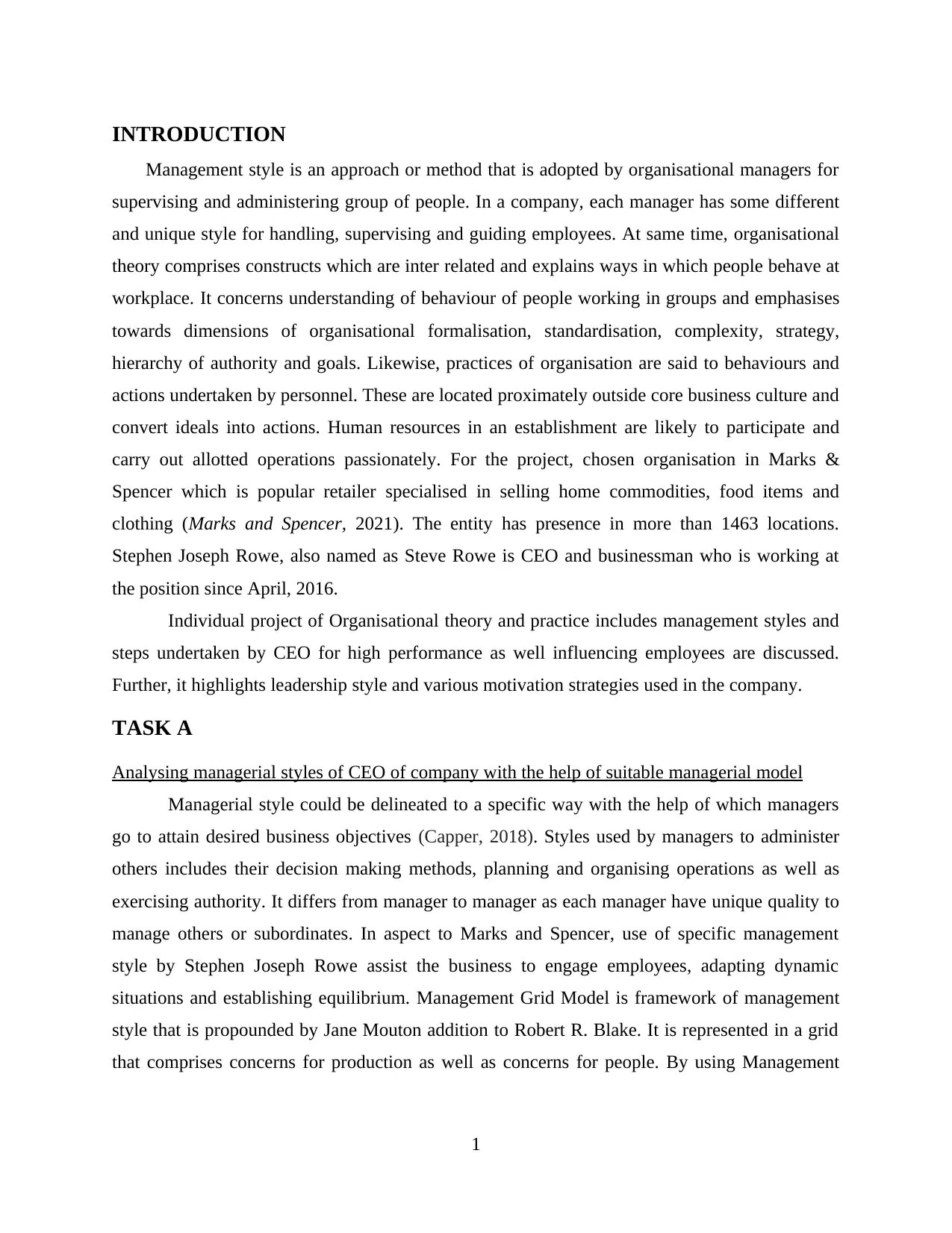
INTRODUCTION
Management style is an approach or method that is adopted by organisational managers for
supervising and administering group of people. In a company, each manager has some different
and unique style for handling, supervising and guiding employees. At same time, organisational
theory comprises constructs which are inter related and explains ways in which people behave at
workplace. It concerns understanding of behaviour of people working in groups and emphasises
towards dimensions of organisational formalisation, standardisation, complexity, strategy,
hierarchy of authority and goals. Likewise, practices of organisation are said to behaviours and
actions undertaken by personnel. These are located proximately outside core business culture and
convert ideals into actions. Human resources in an establishment are likely to participate and
carry out allotted operations passionately. For the project, chosen organisation in Marks &
Spencer which is popular retailer specialised in selling home commodities, food items and
clothing (Marks and Spencer, 2021). The entity has presence in more than 1463 locations.
Stephen Joseph Rowe, also named as Steve Rowe is CEO and businessman who is working at
the position since April, 2016.
Individual project of Organisational theory and practice includes management styles and
steps undertaken by CEO for high performance as well influencing employees are discussed.
Further, it highlights leadership style and various motivation strategies used in the company.
TASK A
Analysing managerial styles of CEO of company with the help of suitable managerial model
Managerial style could be delineated to a specific way with the help of which managers
go to attain desired business objectives (Capper, 2018). Styles used by managers to administer
others includes their decision making methods, planning and organising operations as well as
exercising authority. It differs from manager to manager as each manager have unique quality to
manage others or subordinates. In aspect to Marks and Spencer, use of specific management
style by Stephen Joseph Rowe assist the business to engage employees, adapting dynamic
situations and establishing equilibrium. Management Grid Model is framework of management
style that is propounded by Jane Mouton addition to Robert R. Blake. It is represented in a grid
that comprises concerns for production as well as concerns for people. By using Management
1
Management style is an approach or method that is adopted by organisational managers for
supervising and administering group of people. In a company, each manager has some different
and unique style for handling, supervising and guiding employees. At same time, organisational
theory comprises constructs which are inter related and explains ways in which people behave at
workplace. It concerns understanding of behaviour of people working in groups and emphasises
towards dimensions of organisational formalisation, standardisation, complexity, strategy,
hierarchy of authority and goals. Likewise, practices of organisation are said to behaviours and
actions undertaken by personnel. These are located proximately outside core business culture and
convert ideals into actions. Human resources in an establishment are likely to participate and
carry out allotted operations passionately. For the project, chosen organisation in Marks &
Spencer which is popular retailer specialised in selling home commodities, food items and
clothing (Marks and Spencer, 2021). The entity has presence in more than 1463 locations.
Stephen Joseph Rowe, also named as Steve Rowe is CEO and businessman who is working at
the position since April, 2016.
Individual project of Organisational theory and practice includes management styles and
steps undertaken by CEO for high performance as well influencing employees are discussed.
Further, it highlights leadership style and various motivation strategies used in the company.
TASK A
Analysing managerial styles of CEO of company with the help of suitable managerial model
Managerial style could be delineated to a specific way with the help of which managers
go to attain desired business objectives (Capper, 2018). Styles used by managers to administer
others includes their decision making methods, planning and organising operations as well as
exercising authority. It differs from manager to manager as each manager have unique quality to
manage others or subordinates. In aspect to Marks and Spencer, use of specific management
style by Stephen Joseph Rowe assist the business to engage employees, adapting dynamic
situations and establishing equilibrium. Management Grid Model is framework of management
style that is propounded by Jane Mouton addition to Robert R. Blake. It is represented in a grid
that comprises concerns for production as well as concerns for people. By using Management
1
Secure Best Marks with AI Grader
Need help grading? Try our AI Grader for instant feedback on your assignments.
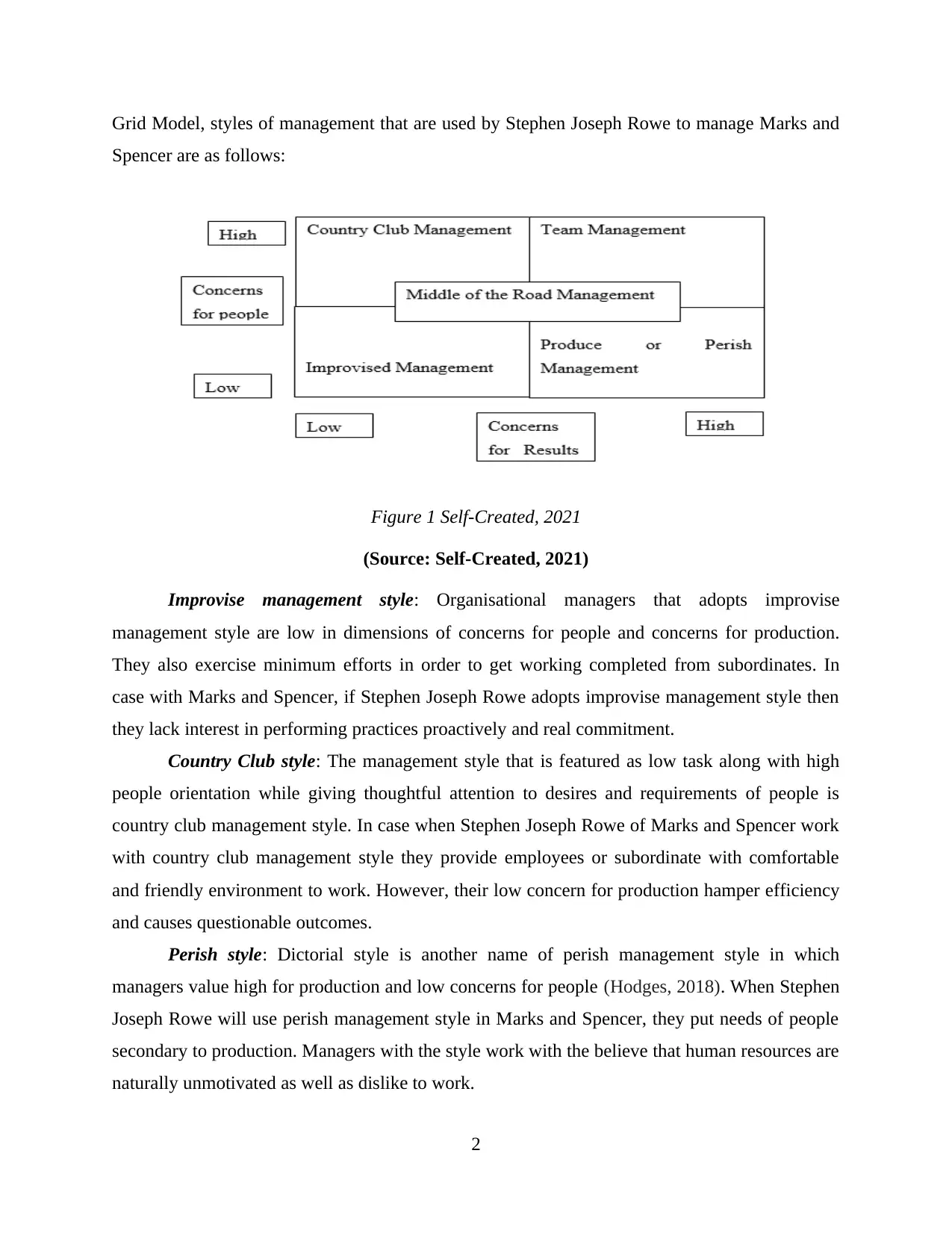
Grid Model, styles of management that are used by Stephen Joseph Rowe to manage Marks and
Spencer are as follows:
Figure 1 Self-Created, 2021
(Source: Self-Created, 2021)
Improvise management style: Organisational managers that adopts improvise
management style are low in dimensions of concerns for people and concerns for production.
They also exercise minimum efforts in order to get working completed from subordinates. In
case with Marks and Spencer, if Stephen Joseph Rowe adopts improvise management style then
they lack interest in performing practices proactively and real commitment.
Country Club style: The management style that is featured as low task along with high
people orientation while giving thoughtful attention to desires and requirements of people is
country club management style. In case when Stephen Joseph Rowe of Marks and Spencer work
with country club management style they provide employees or subordinate with comfortable
and friendly environment to work. However, their low concern for production hamper efficiency
and causes questionable outcomes.
Perish style: Dictorial style is another name of perish management style in which
managers value high for production and low concerns for people (Hodges, 2018). When Stephen
Joseph Rowe will use perish management style in Marks and Spencer, they put needs of people
secondary to production. Managers with the style work with the believe that human resources are
naturally unmotivated as well as dislike to work.
2
Spencer are as follows:
Figure 1 Self-Created, 2021
(Source: Self-Created, 2021)
Improvise management style: Organisational managers that adopts improvise
management style are low in dimensions of concerns for people and concerns for production.
They also exercise minimum efforts in order to get working completed from subordinates. In
case with Marks and Spencer, if Stephen Joseph Rowe adopts improvise management style then
they lack interest in performing practices proactively and real commitment.
Country Club style: The management style that is featured as low task along with high
people orientation while giving thoughtful attention to desires and requirements of people is
country club management style. In case when Stephen Joseph Rowe of Marks and Spencer work
with country club management style they provide employees or subordinate with comfortable
and friendly environment to work. However, their low concern for production hamper efficiency
and causes questionable outcomes.
Perish style: Dictorial style is another name of perish management style in which
managers value high for production and low concerns for people (Hodges, 2018). When Stephen
Joseph Rowe will use perish management style in Marks and Spencer, they put needs of people
secondary to production. Managers with the style work with the believe that human resources are
naturally unmotivated as well as dislike to work.
2
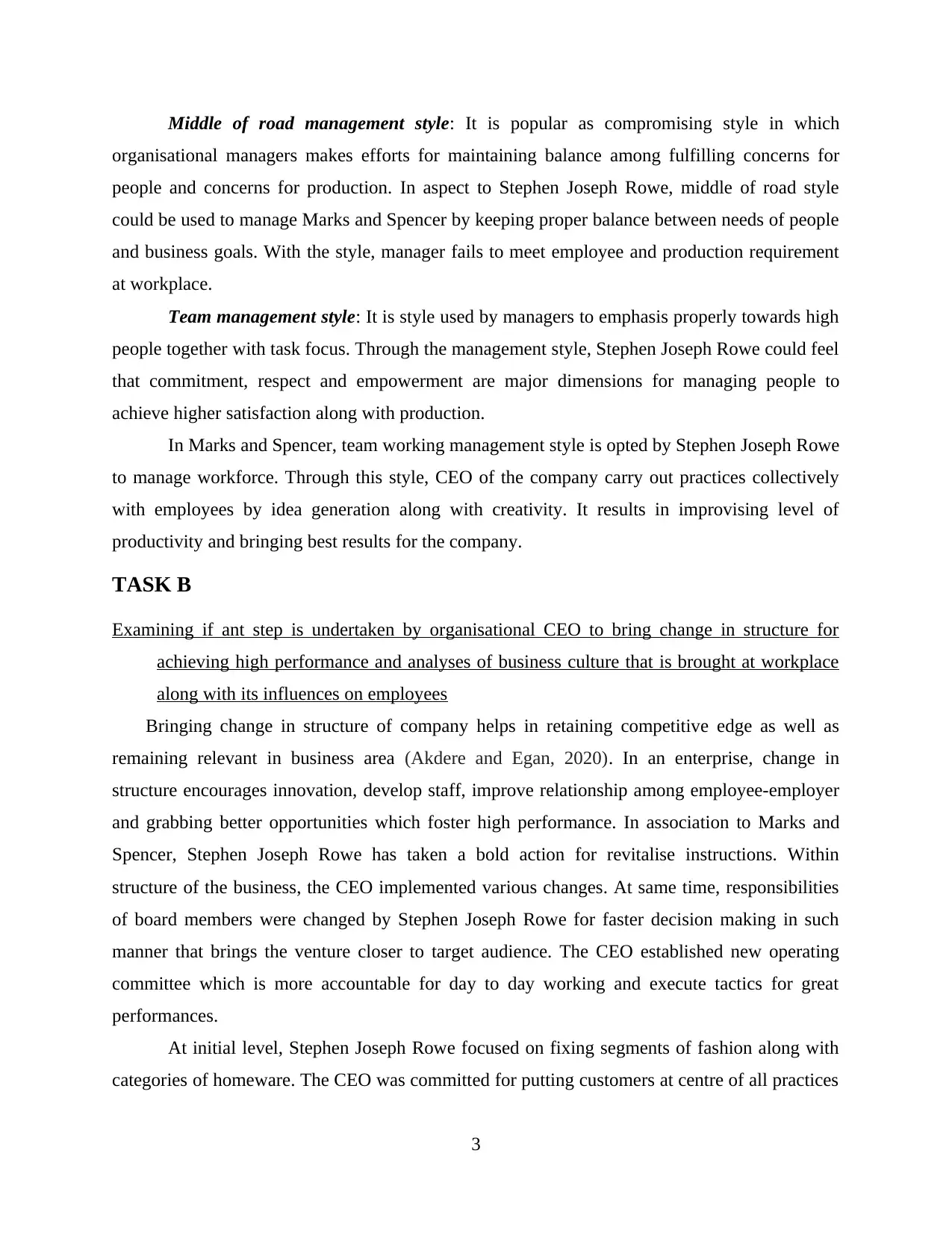
Middle of road management style: It is popular as compromising style in which
organisational managers makes efforts for maintaining balance among fulfilling concerns for
people and concerns for production. In aspect to Stephen Joseph Rowe, middle of road style
could be used to manage Marks and Spencer by keeping proper balance between needs of people
and business goals. With the style, manager fails to meet employee and production requirement
at workplace.
Team management style: It is style used by managers to emphasis properly towards high
people together with task focus. Through the management style, Stephen Joseph Rowe could feel
that commitment, respect and empowerment are major dimensions for managing people to
achieve higher satisfaction along with production.
In Marks and Spencer, team working management style is opted by Stephen Joseph Rowe
to manage workforce. Through this style, CEO of the company carry out practices collectively
with employees by idea generation along with creativity. It results in improvising level of
productivity and bringing best results for the company.
TASK B
Examining if ant step is undertaken by organisational CEO to bring change in structure for
achieving high performance and analyses of business culture that is brought at workplace
along with its influences on employees
Bringing change in structure of company helps in retaining competitive edge as well as
remaining relevant in business area (Akdere and Egan, 2020). In an enterprise, change in
structure encourages innovation, develop staff, improve relationship among employee-employer
and grabbing better opportunities which foster high performance. In association to Marks and
Spencer, Stephen Joseph Rowe has taken a bold action for revitalise instructions. Within
structure of the business, the CEO implemented various changes. At same time, responsibilities
of board members were changed by Stephen Joseph Rowe for faster decision making in such
manner that brings the venture closer to target audience. The CEO established new operating
committee which is more accountable for day to day working and execute tactics for great
performances.
At initial level, Stephen Joseph Rowe focused on fixing segments of fashion along with
categories of homeware. The CEO was committed for putting customers at centre of all practices
3
organisational managers makes efforts for maintaining balance among fulfilling concerns for
people and concerns for production. In aspect to Stephen Joseph Rowe, middle of road style
could be used to manage Marks and Spencer by keeping proper balance between needs of people
and business goals. With the style, manager fails to meet employee and production requirement
at workplace.
Team management style: It is style used by managers to emphasis properly towards high
people together with task focus. Through the management style, Stephen Joseph Rowe could feel
that commitment, respect and empowerment are major dimensions for managing people to
achieve higher satisfaction along with production.
In Marks and Spencer, team working management style is opted by Stephen Joseph Rowe
to manage workforce. Through this style, CEO of the company carry out practices collectively
with employees by idea generation along with creativity. It results in improvising level of
productivity and bringing best results for the company.
TASK B
Examining if ant step is undertaken by organisational CEO to bring change in structure for
achieving high performance and analyses of business culture that is brought at workplace
along with its influences on employees
Bringing change in structure of company helps in retaining competitive edge as well as
remaining relevant in business area (Akdere and Egan, 2020). In an enterprise, change in
structure encourages innovation, develop staff, improve relationship among employee-employer
and grabbing better opportunities which foster high performance. In association to Marks and
Spencer, Stephen Joseph Rowe has taken a bold action for revitalise instructions. Within
structure of the business, the CEO implemented various changes. At same time, responsibilities
of board members were changed by Stephen Joseph Rowe for faster decision making in such
manner that brings the venture closer to target audience. The CEO established new operating
committee which is more accountable for day to day working and execute tactics for great
performances.
At initial level, Stephen Joseph Rowe focused on fixing segments of fashion along with
categories of homeware. The CEO was committed for putting customers at centre of all practices
3
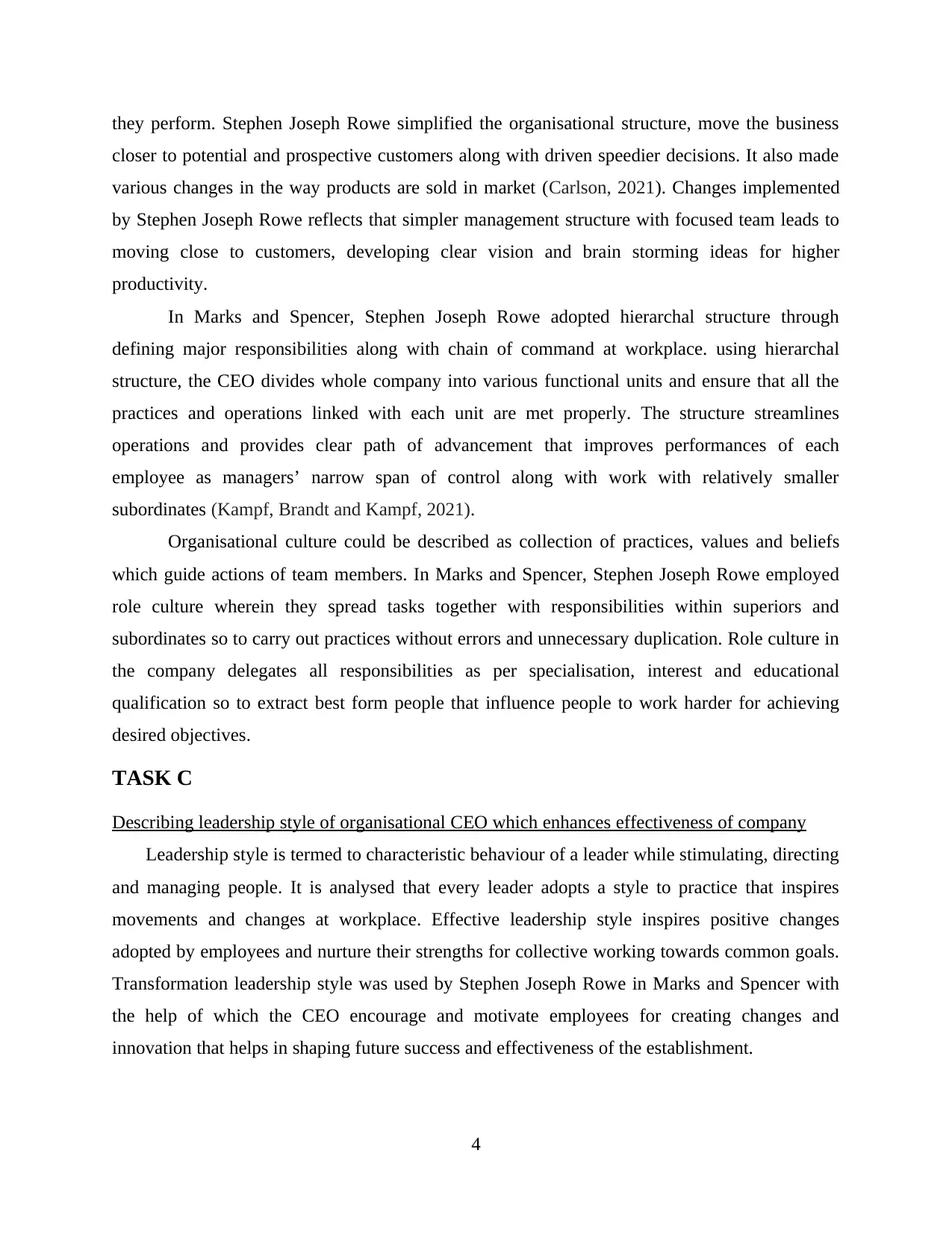
they perform. Stephen Joseph Rowe simplified the organisational structure, move the business
closer to potential and prospective customers along with driven speedier decisions. It also made
various changes in the way products are sold in market (Carlson, 2021). Changes implemented
by Stephen Joseph Rowe reflects that simpler management structure with focused team leads to
moving close to customers, developing clear vision and brain storming ideas for higher
productivity.
In Marks and Spencer, Stephen Joseph Rowe adopted hierarchal structure through
defining major responsibilities along with chain of command at workplace. using hierarchal
structure, the CEO divides whole company into various functional units and ensure that all the
practices and operations linked with each unit are met properly. The structure streamlines
operations and provides clear path of advancement that improves performances of each
employee as managers’ narrow span of control along with work with relatively smaller
subordinates (Kampf, Brandt and Kampf, 2021).
Organisational culture could be described as collection of practices, values and beliefs
which guide actions of team members. In Marks and Spencer, Stephen Joseph Rowe employed
role culture wherein they spread tasks together with responsibilities within superiors and
subordinates so to carry out practices without errors and unnecessary duplication. Role culture in
the company delegates all responsibilities as per specialisation, interest and educational
qualification so to extract best form people that influence people to work harder for achieving
desired objectives.
TASK C
Describing leadership style of organisational CEO which enhances effectiveness of company
Leadership style is termed to characteristic behaviour of a leader while stimulating, directing
and managing people. It is analysed that every leader adopts a style to practice that inspires
movements and changes at workplace. Effective leadership style inspires positive changes
adopted by employees and nurture their strengths for collective working towards common goals.
Transformation leadership style was used by Stephen Joseph Rowe in Marks and Spencer with
the help of which the CEO encourage and motivate employees for creating changes and
innovation that helps in shaping future success and effectiveness of the establishment.
4
closer to potential and prospective customers along with driven speedier decisions. It also made
various changes in the way products are sold in market (Carlson, 2021). Changes implemented
by Stephen Joseph Rowe reflects that simpler management structure with focused team leads to
moving close to customers, developing clear vision and brain storming ideas for higher
productivity.
In Marks and Spencer, Stephen Joseph Rowe adopted hierarchal structure through
defining major responsibilities along with chain of command at workplace. using hierarchal
structure, the CEO divides whole company into various functional units and ensure that all the
practices and operations linked with each unit are met properly. The structure streamlines
operations and provides clear path of advancement that improves performances of each
employee as managers’ narrow span of control along with work with relatively smaller
subordinates (Kampf, Brandt and Kampf, 2021).
Organisational culture could be described as collection of practices, values and beliefs
which guide actions of team members. In Marks and Spencer, Stephen Joseph Rowe employed
role culture wherein they spread tasks together with responsibilities within superiors and
subordinates so to carry out practices without errors and unnecessary duplication. Role culture in
the company delegates all responsibilities as per specialisation, interest and educational
qualification so to extract best form people that influence people to work harder for achieving
desired objectives.
TASK C
Describing leadership style of organisational CEO which enhances effectiveness of company
Leadership style is termed to characteristic behaviour of a leader while stimulating, directing
and managing people. It is analysed that every leader adopts a style to practice that inspires
movements and changes at workplace. Effective leadership style inspires positive changes
adopted by employees and nurture their strengths for collective working towards common goals.
Transformation leadership style was used by Stephen Joseph Rowe in Marks and Spencer with
the help of which the CEO encourage and motivate employees for creating changes and
innovation that helps in shaping future success and effectiveness of the establishment.
4
Paraphrase This Document
Need a fresh take? Get an instant paraphrase of this document with our AI Paraphraser
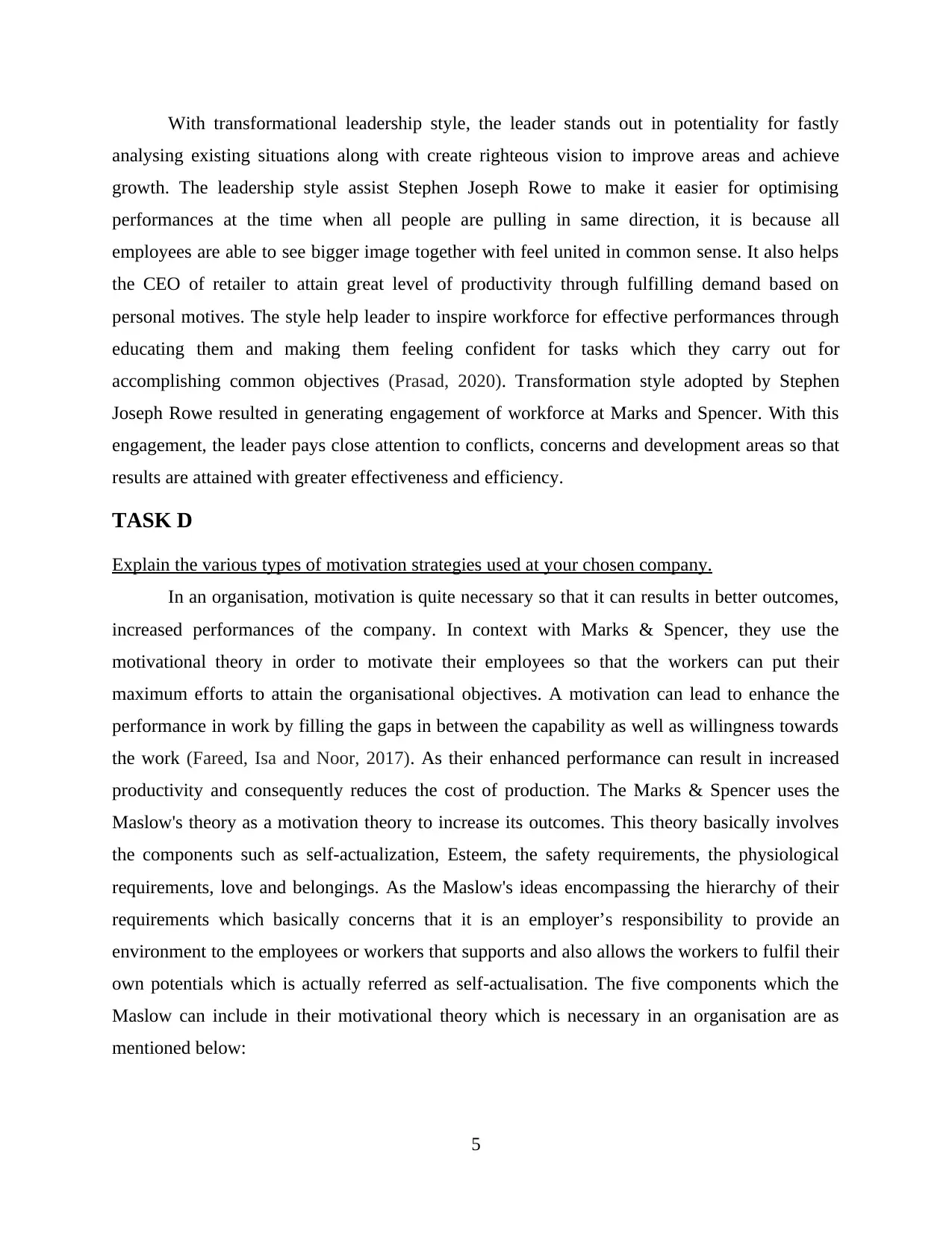
With transformational leadership style, the leader stands out in potentiality for fastly
analysing existing situations along with create righteous vision to improve areas and achieve
growth. The leadership style assist Stephen Joseph Rowe to make it easier for optimising
performances at the time when all people are pulling in same direction, it is because all
employees are able to see bigger image together with feel united in common sense. It also helps
the CEO of retailer to attain great level of productivity through fulfilling demand based on
personal motives. The style help leader to inspire workforce for effective performances through
educating them and making them feeling confident for tasks which they carry out for
accomplishing common objectives (Prasad, 2020). Transformation style adopted by Stephen
Joseph Rowe resulted in generating engagement of workforce at Marks and Spencer. With this
engagement, the leader pays close attention to conflicts, concerns and development areas so that
results are attained with greater effectiveness and efficiency.
TASK D
Explain the various types of motivation strategies used at your chosen company.
In an organisation, motivation is quite necessary so that it can results in better outcomes,
increased performances of the company. In context with Marks & Spencer, they use the
motivational theory in order to motivate their employees so that the workers can put their
maximum efforts to attain the organisational objectives. A motivation can lead to enhance the
performance in work by filling the gaps in between the capability as well as willingness towards
the work (Fareed, Isa and Noor, 2017). As their enhanced performance can result in increased
productivity and consequently reduces the cost of production. The Marks & Spencer uses the
Maslow's theory as a motivation theory to increase its outcomes. This theory basically involves
the components such as self-actualization, Esteem, the safety requirements, the physiological
requirements, love and belongings. As the Maslow's ideas encompassing the hierarchy of their
requirements which basically concerns that it is an employer’s responsibility to provide an
environment to the employees or workers that supports and also allows the workers to fulfil their
own potentials which is actually referred as self-actualisation. The five components which the
Maslow can include in their motivational theory which is necessary in an organisation are as
mentioned below:
5
analysing existing situations along with create righteous vision to improve areas and achieve
growth. The leadership style assist Stephen Joseph Rowe to make it easier for optimising
performances at the time when all people are pulling in same direction, it is because all
employees are able to see bigger image together with feel united in common sense. It also helps
the CEO of retailer to attain great level of productivity through fulfilling demand based on
personal motives. The style help leader to inspire workforce for effective performances through
educating them and making them feeling confident for tasks which they carry out for
accomplishing common objectives (Prasad, 2020). Transformation style adopted by Stephen
Joseph Rowe resulted in generating engagement of workforce at Marks and Spencer. With this
engagement, the leader pays close attention to conflicts, concerns and development areas so that
results are attained with greater effectiveness and efficiency.
TASK D
Explain the various types of motivation strategies used at your chosen company.
In an organisation, motivation is quite necessary so that it can results in better outcomes,
increased performances of the company. In context with Marks & Spencer, they use the
motivational theory in order to motivate their employees so that the workers can put their
maximum efforts to attain the organisational objectives. A motivation can lead to enhance the
performance in work by filling the gaps in between the capability as well as willingness towards
the work (Fareed, Isa and Noor, 2017). As their enhanced performance can result in increased
productivity and consequently reduces the cost of production. The Marks & Spencer uses the
Maslow's theory as a motivation theory to increase its outcomes. This theory basically involves
the components such as self-actualization, Esteem, the safety requirements, the physiological
requirements, love and belongings. As the Maslow's ideas encompassing the hierarchy of their
requirements which basically concerns that it is an employer’s responsibility to provide an
environment to the employees or workers that supports and also allows the workers to fulfil their
own potentials which is actually referred as self-actualisation. The five components which the
Maslow can include in their motivational theory which is necessary in an organisation are as
mentioned below:
5
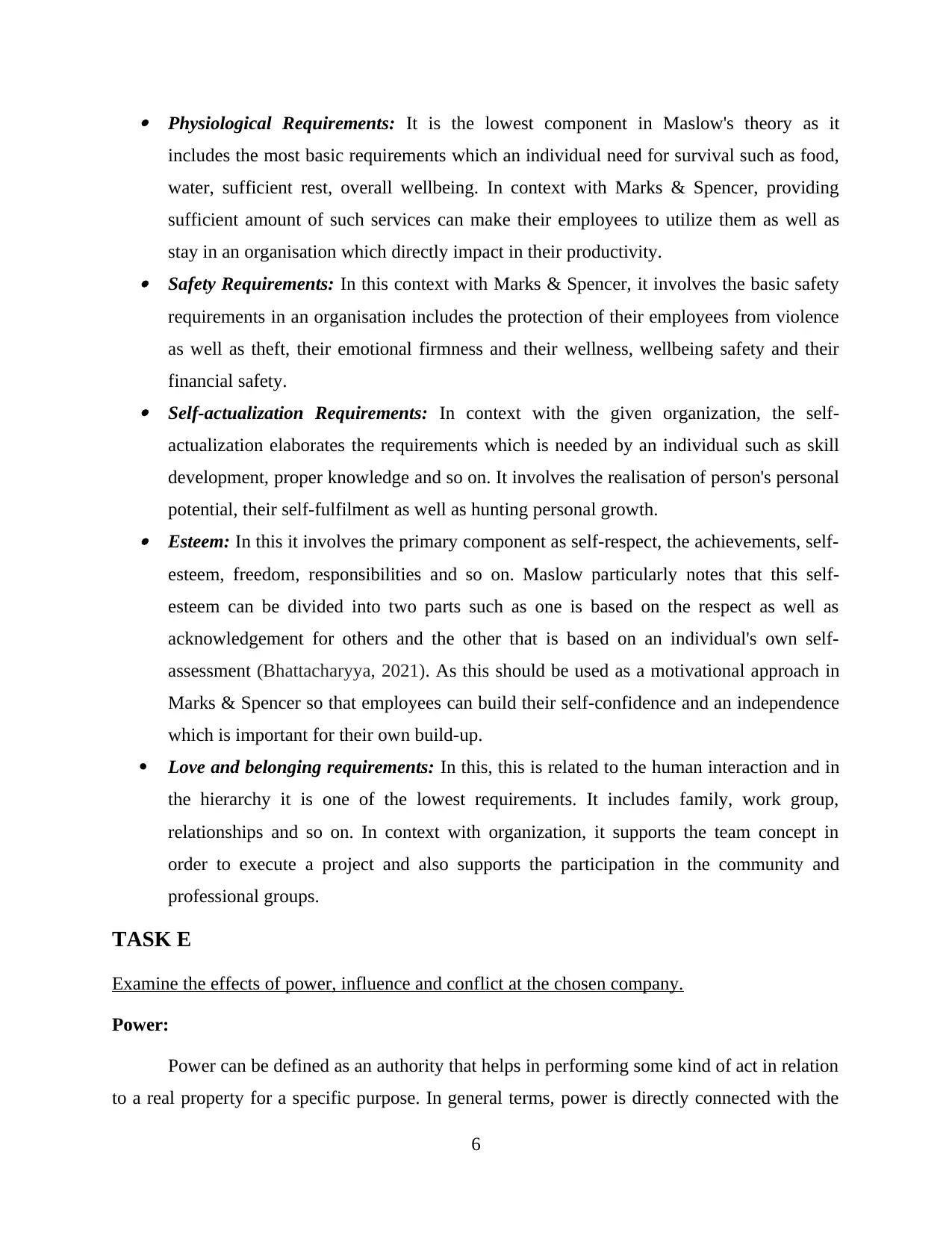
Physiological Requirements: It is the lowest component in Maslow's theory as it
includes the most basic requirements which an individual need for survival such as food,
water, sufficient rest, overall wellbeing. In context with Marks & Spencer, providing
sufficient amount of such services can make their employees to utilize them as well as
stay in an organisation which directly impact in their productivity. Safety Requirements: In this context with Marks & Spencer, it involves the basic safety
requirements in an organisation includes the protection of their employees from violence
as well as theft, their emotional firmness and their wellness, wellbeing safety and their
financial safety. Self-actualization Requirements: In context with the given organization, the self-
actualization elaborates the requirements which is needed by an individual such as skill
development, proper knowledge and so on. It involves the realisation of person's personal
potential, their self-fulfilment as well as hunting personal growth. Esteem: In this it involves the primary component as self-respect, the achievements, self-
esteem, freedom, responsibilities and so on. Maslow particularly notes that this self-
esteem can be divided into two parts such as one is based on the respect as well as
acknowledgement for others and the other that is based on an individual's own self-
assessment (Bhattacharyya, 2021). As this should be used as a motivational approach in
Marks & Spencer so that employees can build their self-confidence and an independence
which is important for their own build-up.
Love and belonging requirements: In this, this is related to the human interaction and in
the hierarchy it is one of the lowest requirements. It includes family, work group,
relationships and so on. In context with organization, it supports the team concept in
order to execute a project and also supports the participation in the community and
professional groups.
TASK E
Examine the effects of power, influence and conflict at the chosen company.
Power:
Power can be defined as an authority that helps in performing some kind of act in relation
to a real property for a specific purpose. In general terms, power is directly connected with the
6
includes the most basic requirements which an individual need for survival such as food,
water, sufficient rest, overall wellbeing. In context with Marks & Spencer, providing
sufficient amount of such services can make their employees to utilize them as well as
stay in an organisation which directly impact in their productivity. Safety Requirements: In this context with Marks & Spencer, it involves the basic safety
requirements in an organisation includes the protection of their employees from violence
as well as theft, their emotional firmness and their wellness, wellbeing safety and their
financial safety. Self-actualization Requirements: In context with the given organization, the self-
actualization elaborates the requirements which is needed by an individual such as skill
development, proper knowledge and so on. It involves the realisation of person's personal
potential, their self-fulfilment as well as hunting personal growth. Esteem: In this it involves the primary component as self-respect, the achievements, self-
esteem, freedom, responsibilities and so on. Maslow particularly notes that this self-
esteem can be divided into two parts such as one is based on the respect as well as
acknowledgement for others and the other that is based on an individual's own self-
assessment (Bhattacharyya, 2021). As this should be used as a motivational approach in
Marks & Spencer so that employees can build their self-confidence and an independence
which is important for their own build-up.
Love and belonging requirements: In this, this is related to the human interaction and in
the hierarchy it is one of the lowest requirements. It includes family, work group,
relationships and so on. In context with organization, it supports the team concept in
order to execute a project and also supports the participation in the community and
professional groups.
TASK E
Examine the effects of power, influence and conflict at the chosen company.
Power:
Power can be defined as an authority that helps in performing some kind of act in relation
to a real property for a specific purpose. In general terms, power is directly connected with the
6
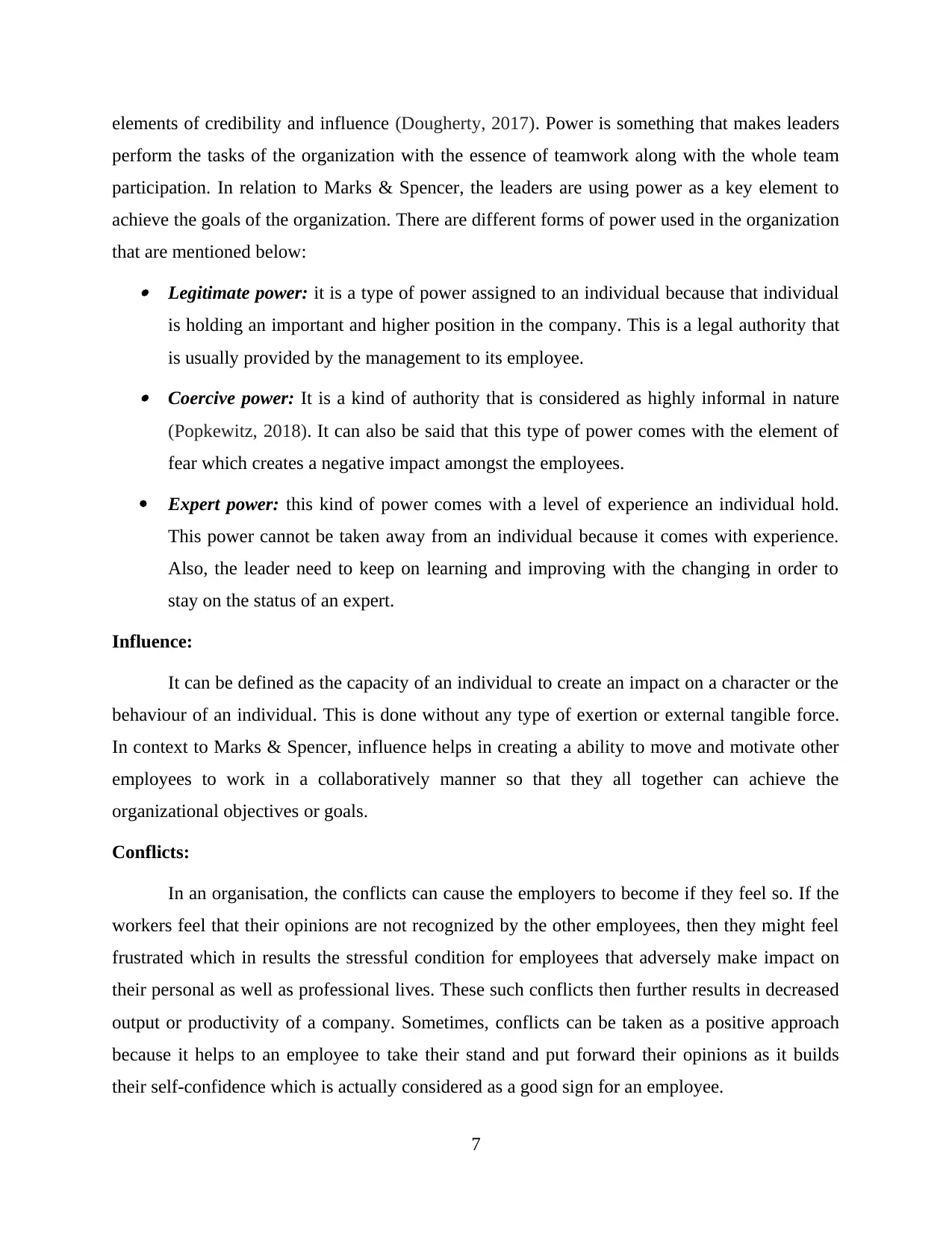
elements of credibility and influence (Dougherty, 2017). Power is something that makes leaders
perform the tasks of the organization with the essence of teamwork along with the whole team
participation. In relation to Marks & Spencer, the leaders are using power as a key element to
achieve the goals of the organization. There are different forms of power used in the organization
that are mentioned below: Legitimate power: it is a type of power assigned to an individual because that individual
is holding an important and higher position in the company. This is a legal authority that
is usually provided by the management to its employee. Coercive power: It is a kind of authority that is considered as highly informal in nature
(Popkewitz, 2018). It can also be said that this type of power comes with the element of
fear which creates a negative impact amongst the employees.
Expert power: this kind of power comes with a level of experience an individual hold.
This power cannot be taken away from an individual because it comes with experience.
Also, the leader need to keep on learning and improving with the changing in order to
stay on the status of an expert.
Influence:
It can be defined as the capacity of an individual to create an impact on a character or the
behaviour of an individual. This is done without any type of exertion or external tangible force.
In context to Marks & Spencer, influence helps in creating a ability to move and motivate other
employees to work in a collaboratively manner so that they all together can achieve the
organizational objectives or goals.
Conflicts:
In an organisation, the conflicts can cause the employers to become if they feel so. If the
workers feel that their opinions are not recognized by the other employees, then they might feel
frustrated which in results the stressful condition for employees that adversely make impact on
their personal as well as professional lives. These such conflicts then further results in decreased
output or productivity of a company. Sometimes, conflicts can be taken as a positive approach
because it helps to an employee to take their stand and put forward their opinions as it builds
their self-confidence which is actually considered as a good sign for an employee.
7
perform the tasks of the organization with the essence of teamwork along with the whole team
participation. In relation to Marks & Spencer, the leaders are using power as a key element to
achieve the goals of the organization. There are different forms of power used in the organization
that are mentioned below: Legitimate power: it is a type of power assigned to an individual because that individual
is holding an important and higher position in the company. This is a legal authority that
is usually provided by the management to its employee. Coercive power: It is a kind of authority that is considered as highly informal in nature
(Popkewitz, 2018). It can also be said that this type of power comes with the element of
fear which creates a negative impact amongst the employees.
Expert power: this kind of power comes with a level of experience an individual hold.
This power cannot be taken away from an individual because it comes with experience.
Also, the leader need to keep on learning and improving with the changing in order to
stay on the status of an expert.
Influence:
It can be defined as the capacity of an individual to create an impact on a character or the
behaviour of an individual. This is done without any type of exertion or external tangible force.
In context to Marks & Spencer, influence helps in creating a ability to move and motivate other
employees to work in a collaboratively manner so that they all together can achieve the
organizational objectives or goals.
Conflicts:
In an organisation, the conflicts can cause the employers to become if they feel so. If the
workers feel that their opinions are not recognized by the other employees, then they might feel
frustrated which in results the stressful condition for employees that adversely make impact on
their personal as well as professional lives. These such conflicts then further results in decreased
output or productivity of a company. Sometimes, conflicts can be taken as a positive approach
because it helps to an employee to take their stand and put forward their opinions as it builds
their self-confidence which is actually considered as a good sign for an employee.
7
Secure Best Marks with AI Grader
Need help grading? Try our AI Grader for instant feedback on your assignments.
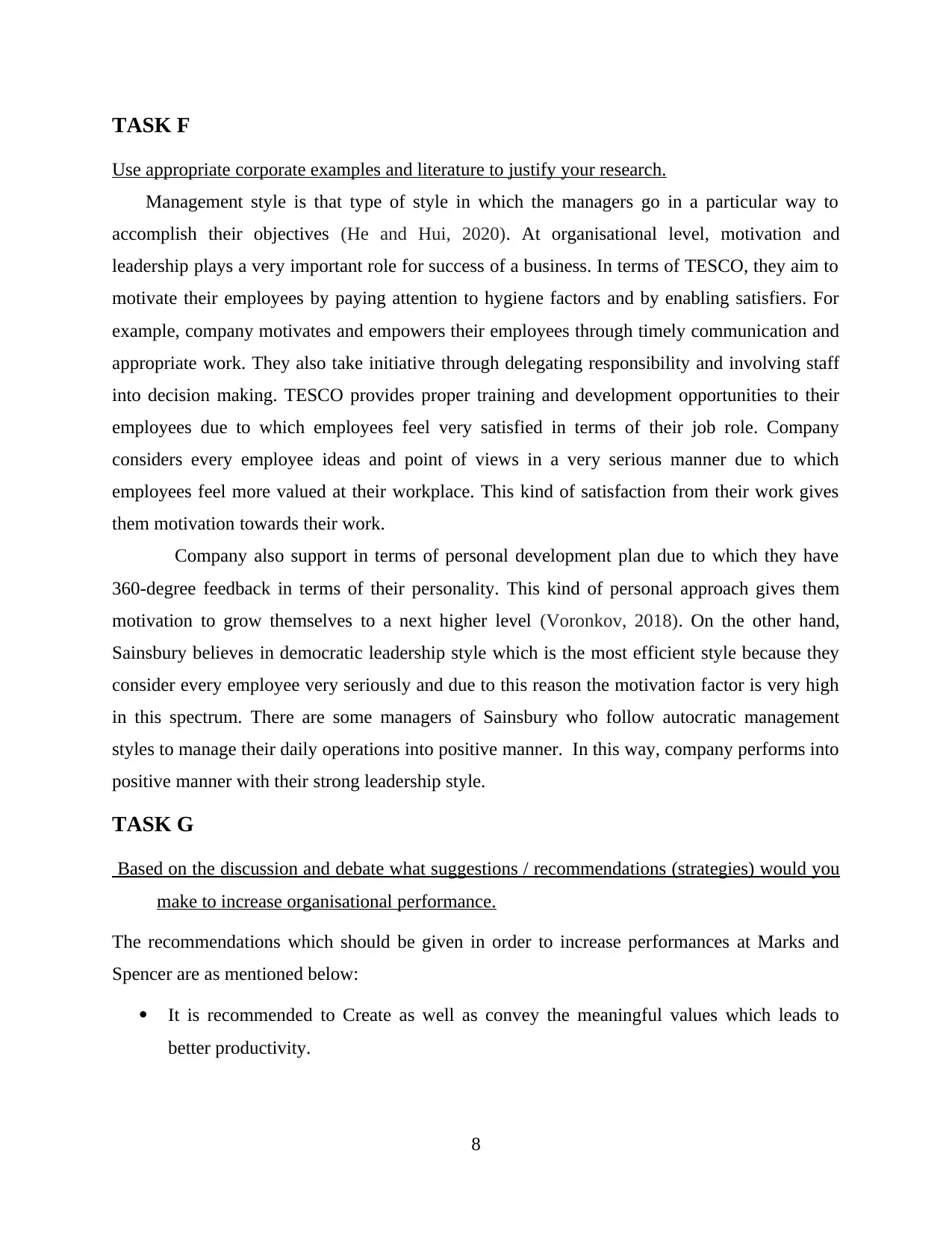
TASK F
Use appropriate corporate examples and literature to justify your research.
Management style is that type of style in which the managers go in a particular way to
accomplish their objectives (He and Hui, 2020). At organisational level, motivation and
leadership plays a very important role for success of a business. In terms of TESCO, they aim to
motivate their employees by paying attention to hygiene factors and by enabling satisfiers. For
example, company motivates and empowers their employees through timely communication and
appropriate work. They also take initiative through delegating responsibility and involving staff
into decision making. TESCO provides proper training and development opportunities to their
employees due to which employees feel very satisfied in terms of their job role. Company
considers every employee ideas and point of views in a very serious manner due to which
employees feel more valued at their workplace. This kind of satisfaction from their work gives
them motivation towards their work.
Company also support in terms of personal development plan due to which they have
360-degree feedback in terms of their personality. This kind of personal approach gives them
motivation to grow themselves to a next higher level (Voronkov, 2018). On the other hand,
Sainsbury believes in democratic leadership style which is the most efficient style because they
consider every employee very seriously and due to this reason the motivation factor is very high
in this spectrum. There are some managers of Sainsbury who follow autocratic management
styles to manage their daily operations into positive manner. In this way, company performs into
positive manner with their strong leadership style.
TASK G
Based on the discussion and debate what suggestions / recommendations (strategies) would you
make to increase organisational performance.
The recommendations which should be given in order to increase performances at Marks and
Spencer are as mentioned below:
It is recommended to Create as well as convey the meaningful values which leads to
better productivity.
8
Use appropriate corporate examples and literature to justify your research.
Management style is that type of style in which the managers go in a particular way to
accomplish their objectives (He and Hui, 2020). At organisational level, motivation and
leadership plays a very important role for success of a business. In terms of TESCO, they aim to
motivate their employees by paying attention to hygiene factors and by enabling satisfiers. For
example, company motivates and empowers their employees through timely communication and
appropriate work. They also take initiative through delegating responsibility and involving staff
into decision making. TESCO provides proper training and development opportunities to their
employees due to which employees feel very satisfied in terms of their job role. Company
considers every employee ideas and point of views in a very serious manner due to which
employees feel more valued at their workplace. This kind of satisfaction from their work gives
them motivation towards their work.
Company also support in terms of personal development plan due to which they have
360-degree feedback in terms of their personality. This kind of personal approach gives them
motivation to grow themselves to a next higher level (Voronkov, 2018). On the other hand,
Sainsbury believes in democratic leadership style which is the most efficient style because they
consider every employee very seriously and due to this reason the motivation factor is very high
in this spectrum. There are some managers of Sainsbury who follow autocratic management
styles to manage their daily operations into positive manner. In this way, company performs into
positive manner with their strong leadership style.
TASK G
Based on the discussion and debate what suggestions / recommendations (strategies) would you
make to increase organisational performance.
The recommendations which should be given in order to increase performances at Marks and
Spencer are as mentioned below:
It is recommended to Create as well as convey the meaningful values which leads to
better productivity.
8
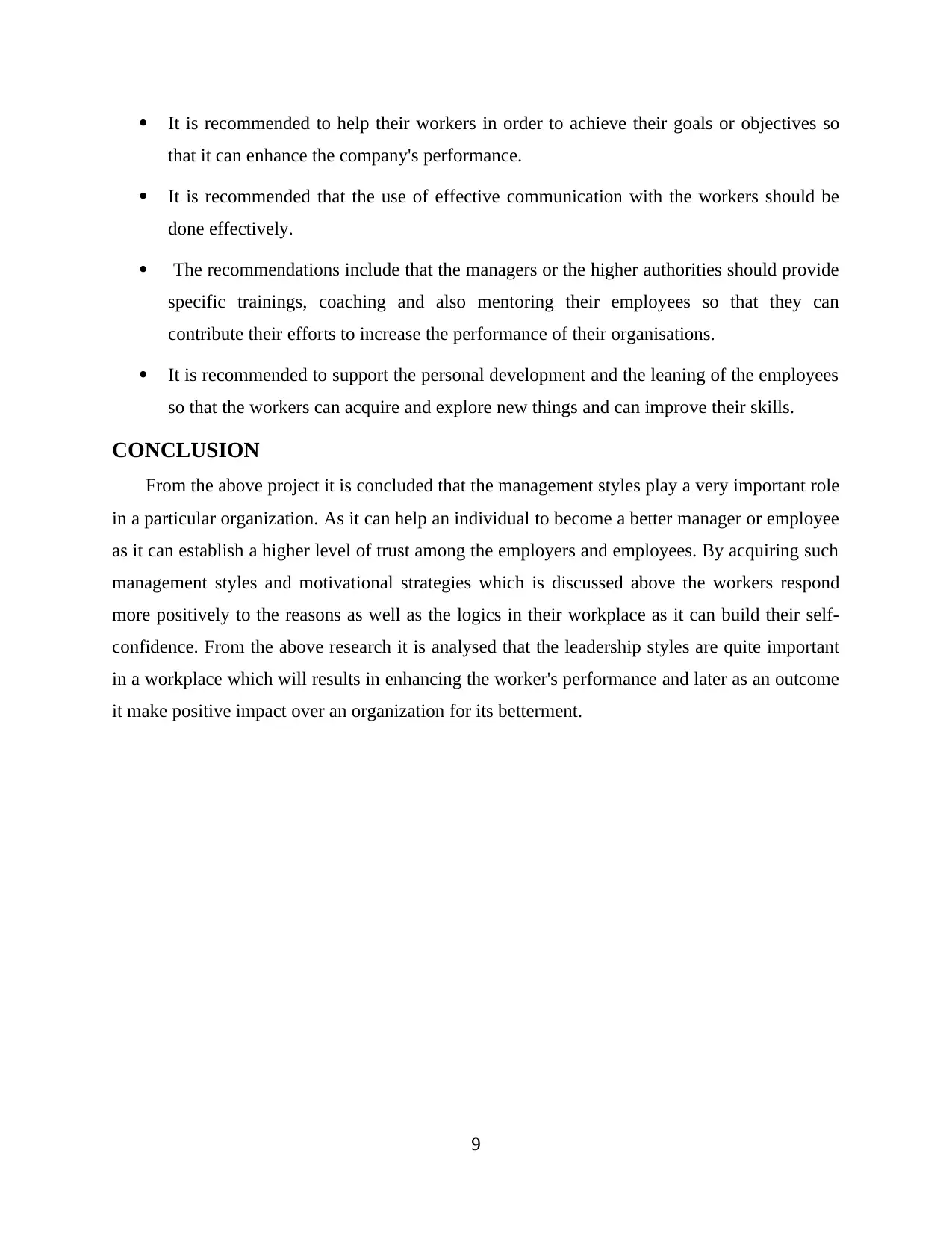
It is recommended to help their workers in order to achieve their goals or objectives so
that it can enhance the company's performance.
It is recommended that the use of effective communication with the workers should be
done effectively.
The recommendations include that the managers or the higher authorities should provide
specific trainings, coaching and also mentoring their employees so that they can
contribute their efforts to increase the performance of their organisations.
It is recommended to support the personal development and the leaning of the employees
so that the workers can acquire and explore new things and can improve their skills.
CONCLUSION
From the above project it is concluded that the management styles play a very important role
in a particular organization. As it can help an individual to become a better manager or employee
as it can establish a higher level of trust among the employers and employees. By acquiring such
management styles and motivational strategies which is discussed above the workers respond
more positively to the reasons as well as the logics in their workplace as it can build their self-
confidence. From the above research it is analysed that the leadership styles are quite important
in a workplace which will results in enhancing the worker's performance and later as an outcome
it make positive impact over an organization for its betterment.
9
that it can enhance the company's performance.
It is recommended that the use of effective communication with the workers should be
done effectively.
The recommendations include that the managers or the higher authorities should provide
specific trainings, coaching and also mentoring their employees so that they can
contribute their efforts to increase the performance of their organisations.
It is recommended to support the personal development and the leaning of the employees
so that the workers can acquire and explore new things and can improve their skills.
CONCLUSION
From the above project it is concluded that the management styles play a very important role
in a particular organization. As it can help an individual to become a better manager or employee
as it can establish a higher level of trust among the employers and employees. By acquiring such
management styles and motivational strategies which is discussed above the workers respond
more positively to the reasons as well as the logics in their workplace as it can build their self-
confidence. From the above research it is analysed that the leadership styles are quite important
in a workplace which will results in enhancing the worker's performance and later as an outcome
it make positive impact over an organization for its betterment.
9

REFERENCES
Books and Journals:
Akdere, M. and Egan, T., 2020. Transformational leadership and human resource development:
Linking employee learning, job satisfaction, and organizational performance. Human
Resource Development Quarterly, 31(4), pp.393-421.
Bhattacharyya, S. S., 2021. Elucidating technology-based social entrepreneurs’ scale and scope
perspectives: a study of environmental and organizational variables. International
Journal of Organizational Analysis.
Capper, C. A., 2018. Organizational theory for equity and diversity: Leading integrated, socially
just education. Routledge.
Dougherty, D., 2017. Grounded theory research methods. The Blackwell companion to
organizations, pp.849-866.
Fareed, M., Isa, M. F. M. and Noor, W. S. W. M., 2017. Human resource professionals’
effectiveness, organizational culture and high performance work system link: Evidence
from Pakistan. International Review of Management and Marketing, 7(1), pp.85-94.
He, Q. and Hui, D., 2020. Organizational Intrapreneurship Policy, Entrepreneur Subjectivity, and
Employees' Intrapreneurship Activity. International Journal of Information Systems in
the Service Sector (IJISSS), 12(1), pp.1-15.
Hodges, J., 2018. Employee engagement for organizational change: the theory and practice of
stakeholder engagement.
Kampf, C. E., Brandt, C. J. and Kampf, C. G., 2021. Using action research in innovation project
management: building legitimacy and organizational learning in an SME during a
merger process. International Journal of Managing Projects in Business.
Popkewitz, T. S. ed., 2018. Critical studies in teacher education: Its folklore, theory and
practice. Routledge.
Prasad, L.M., 2020. Principles and practice of management. Sultan Chand & Sons.
Voronkov, I., 2018, June. Evaluation and improvement of the reliability of organizational
structures of ICP by the method of hierarchy analysis. In IOP Conference Series:
Materials Science and Engineering (Vol. 365, No. 6, p. 062035). IOP Publishing.
Online:
Carlson. C. L. 2021. Marks & Spencer makes changes to management structure. [Online].
Available through: < https://uk.fashionnetwork.com/news/marks-spencer-makes-
changes-to-management-structure,692077.html>
Marks and Spencer. 2021. [Online]. Available through: <http://www.marksandspencer.com/>
10
Books and Journals:
Akdere, M. and Egan, T., 2020. Transformational leadership and human resource development:
Linking employee learning, job satisfaction, and organizational performance. Human
Resource Development Quarterly, 31(4), pp.393-421.
Bhattacharyya, S. S., 2021. Elucidating technology-based social entrepreneurs’ scale and scope
perspectives: a study of environmental and organizational variables. International
Journal of Organizational Analysis.
Capper, C. A., 2018. Organizational theory for equity and diversity: Leading integrated, socially
just education. Routledge.
Dougherty, D., 2017. Grounded theory research methods. The Blackwell companion to
organizations, pp.849-866.
Fareed, M., Isa, M. F. M. and Noor, W. S. W. M., 2017. Human resource professionals’
effectiveness, organizational culture and high performance work system link: Evidence
from Pakistan. International Review of Management and Marketing, 7(1), pp.85-94.
He, Q. and Hui, D., 2020. Organizational Intrapreneurship Policy, Entrepreneur Subjectivity, and
Employees' Intrapreneurship Activity. International Journal of Information Systems in
the Service Sector (IJISSS), 12(1), pp.1-15.
Hodges, J., 2018. Employee engagement for organizational change: the theory and practice of
stakeholder engagement.
Kampf, C. E., Brandt, C. J. and Kampf, C. G., 2021. Using action research in innovation project
management: building legitimacy and organizational learning in an SME during a
merger process. International Journal of Managing Projects in Business.
Popkewitz, T. S. ed., 2018. Critical studies in teacher education: Its folklore, theory and
practice. Routledge.
Prasad, L.M., 2020. Principles and practice of management. Sultan Chand & Sons.
Voronkov, I., 2018, June. Evaluation and improvement of the reliability of organizational
structures of ICP by the method of hierarchy analysis. In IOP Conference Series:
Materials Science and Engineering (Vol. 365, No. 6, p. 062035). IOP Publishing.
Online:
Carlson. C. L. 2021. Marks & Spencer makes changes to management structure. [Online].
Available through: < https://uk.fashionnetwork.com/news/marks-spencer-makes-
changes-to-management-structure,692077.html>
Marks and Spencer. 2021. [Online]. Available through: <http://www.marksandspencer.com/>
10
1 out of 13
Related Documents
Your All-in-One AI-Powered Toolkit for Academic Success.
+13062052269
info@desklib.com
Available 24*7 on WhatsApp / Email
![[object Object]](/_next/static/media/star-bottom.7253800d.svg)
Unlock your academic potential
© 2024 | Zucol Services PVT LTD | All rights reserved.



